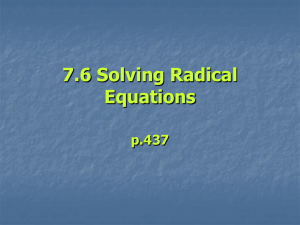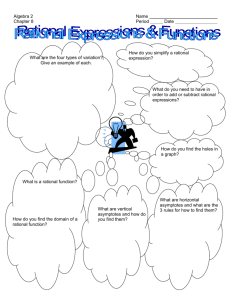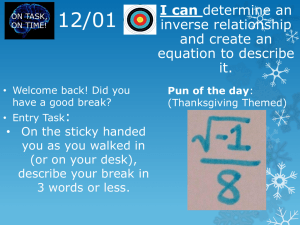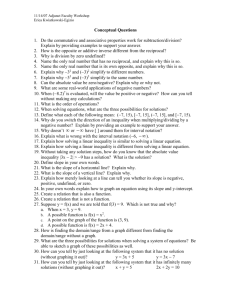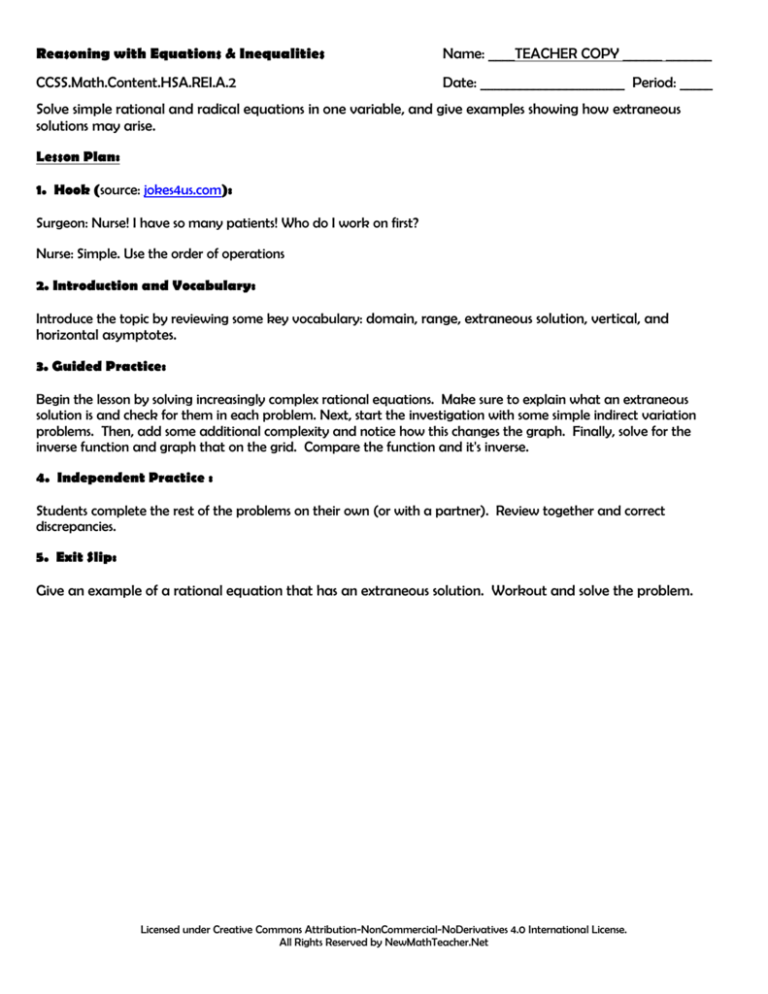
Reasoning with Equations & Inequalities
Name: ____TEACHER COPY ______ _______
CCSS.Math.Content.HSA.REI.A.2
Date: ______________________ Period: _____
Solve simple rational and radical equations in one variable, and give examples showing how extraneous
solutions may arise.
Lesson Plan:
1. Hook (source: jokes4us.com):
Surgeon: Nurse! I have so many patients! Who do I work on first?
Nurse: Simple. Use the order of operations
2. Introduction and Vocabulary:
Introduce the topic by reviewing some key vocabulary: domain, range, extraneous solution, vertical, and
horizontal asymptotes.
3. Guided Practice:
Begin the lesson by solving increasingly complex rational equations. Make sure to explain what an extraneous
solution is and check for them in each problem. Next, start the investigation with some simple indirect variation
problems. Then, add some additional complexity and notice how this changes the graph. Finally, solve for the
inverse function and graph that on the grid. Compare the function and it's inverse.
4. Independent Practice :
Students complete the rest of the problems on their own (or with a partner). Review together and correct
discrepancies.
5. Exit Slip:
Give an example of a rational equation that has an extraneous solution. Workout and solve the problem.
Licensed under Creative Commons Attribution-NonCommercial-NoDerivatives 4.0 International License.
All Rights Reserved by NewMathTeacher.Net
Reasoning with Equations & Inequalities
CCSS.Math.Content.HSA.REI.A.2
Name: ____TEACHER COPY ______ _______
Date: ______________________ Period: _____
Solve simple rational and radical equations in one variable, and give examples showing how extraneous
solutions may arise.
SOLVING RATIONAL EQUATIONS
Where do these equations show up in real life?
Sports Statistics – how many points must you score to have a certain batting/shooting percentage
Biology – food consumed vs. time
Chemistry – volume of acid solution and concentration of a solution
What are we going to do?
We will solve rational equations using what we know about LCD’s, factoring, and dividing fractions.
I. Solving a Rational Equation with One Solution
To solve a rational equation, multiply each term on both sides of the equation by the LCD of the terms. Simplify
and solve the resulting polynomial equation. Make sure to check for extraneous solutions.
To solve a rational equation for which each side of the equation is a single rational expression, use cross
multiplying.
1.
7
1 5
x 3x 3
2.
3
2
4
x x1 x
II. Solving a Rational Equation with Two Solutions
3.
5x
14
2 2
x1
x 1
4.
2x
4x 1
17 x 4
x 2 3x 2 3x2 4 x 4
Licensed under Creative Commons Attribution-NonCommercial-NoDerivatives 4.0 International License.
All Rights Reserved by NewMathTeacher.Net
III. Writing and Using a Rational Model
5. Average Cost A greeting card manufacturer can produce a dozen cards for $6.50. If the initial investment
by the company was $60,000, how many dozen cards must be produced before the average cost per dozen
falls to $11.50?
s2
6. Brakes The braking distance of a car can be modeled by d s
where d is the distance (in feet) that
20
the car travels before coming to a stop, and s is the speed at which the car is traveling (in miles per hour). Find
the speed that results in a braking distance of 75 feet.
Licensed under Creative Commons Attribution-NonCommercial-NoDerivatives 4.0 International License.
All Rights Reserved by NewMathTeacher.Net
Reasoning with Equations & Inequalities
CCSS.Math.Content.HSA.REI.A.2
Name: ____TEACHER COPY ______ _______
Date: ______________________ Period: _____
Solve simple rational and radical equations in one variable, and give examples showing how extraneous
solutions may arise.
GRAPHING SIMPLE RATIONAL FUNCTIONS
Where do these equations show up in real life?
Doppler Effect – source of a sound moves relative to a stationary listener
Economics – Laffer Curve on tax rate versus government revenue
Thunder & Lightning – air temperature affects speed of sound (but not light)
What are we going to do?
In this lesson we will graph simple rational functions and use the graph of a rational function to solve
real-life problems.
Remember: Two variables x and y show direct variation if y = kx for some nonzero constant k.
Another type of variation we will study in this chapter is called inverse variation. Two variables x and y
show inverse variation if y
said to vary inversely with x.
k
; k 0 . The nonzero constant k is called the constant of variation, and y is
x
I. Investigation of Simple Rational Graphs
1. Using your graphing calculator, graph each function of the form y
a. y
1
x
b. y
4
x
c. y
2. How does the sign of a affect the graph of y
3. How does a affect the graph of y
1
x
a
.
x
d. y
a
?
x
a
?
x
4. Again using your graphing calculator, graph each function of the form y
a
k.
xh
Licensed under Creative Commons Attribution-NonCommercial-NoDerivatives 4.0 International License.
All Rights Reserved by NewMathTeacher.Net
4
x
Choose a viewing window that displays the intercepts & asymptotes of the graph.
a. y
1
x2
b. y
1
x2
c. y
5. How does the value h affect the graph of y
a
k?
xh
6. How does the value k affect the graph of y
a
k?
xh
7. Now graph the function y
1
2
x
d. y
1
2
x
3
2.
x1
8. What is the equation of the vertical asymptote of this graph?
9. What is the equation of the horizontal asymptote of this graph?
10. Using the general form of the function y
a
k , what is always the vertical asymptote?
xh
11. Using the general form of the function y
a
k , what is always the horizontal asymptote?
xh
12. Why will these values always dictate these asymptotes?
Licensed under Creative Commons Attribution-NonCommercial-NoDerivatives 4.0 International License.
All Rights Reserved by NewMathTeacher.Net
Reasoning with Equations & Inequalities
CCSS.Math.Content.HSA.REI.A.2
Name: ____TEACHER COPY ______ _______
Date: ______________________ Period: _____
Solve simple rational and radical equations in one variable, and give examples showing how extraneous
solutions may arise.
MORE EXPLORATION OF RATIONAL FUNCTIONS
1.
Simplify the right side of the rational function y
x2
and state any restrictions.
x 5x 6
2
2. Now graph this simplified version of the rational function/hyperbola on the x-y graph below.
What is the equation of the vertical asymptote of this graph?
What is the equation of the horizontal asymptote of this graph?
3. What is the inverse of this simplified rational function? Show it in “y=” form.
4. Now graph this inverse of the original rational function/hyperbola on the x-y graph below.
What is the equation of the vertical asymptote of this graph?
What is the equation of the horizontal asymptote of this graph?
5. Compare the two functions. List three characteristics that back up the fact that they are inverses.
Licensed under Creative Commons Attribution-NonCommercial-NoDerivatives 4.0 International License.
All Rights Reserved by NewMathTeacher.Net
INDEPENDENT PRACTICE:
Match each function with its graph by stating the domain, range, vertical, and horizontal asymptotes of each.
𝑓(𝑥) =
2
𝑥−3
+1
𝑓(𝑥) =
𝑥+3
𝑥+2
𝑓(𝑥) =
2𝑥−3
𝑥−3
D:
D:
D:
R:
R:
R:
VA: x = _____
VA: x = _____
VA: x = _____
HA: y = _____
HA: y = _____
HA: y = _____
Sketch below:
Sketch below:
Sketch below:
Licensed under Creative Commons Attribution-NonCommercial-NoDerivatives 4.0 International License.
All Rights Reserved by NewMathTeacher.Net



